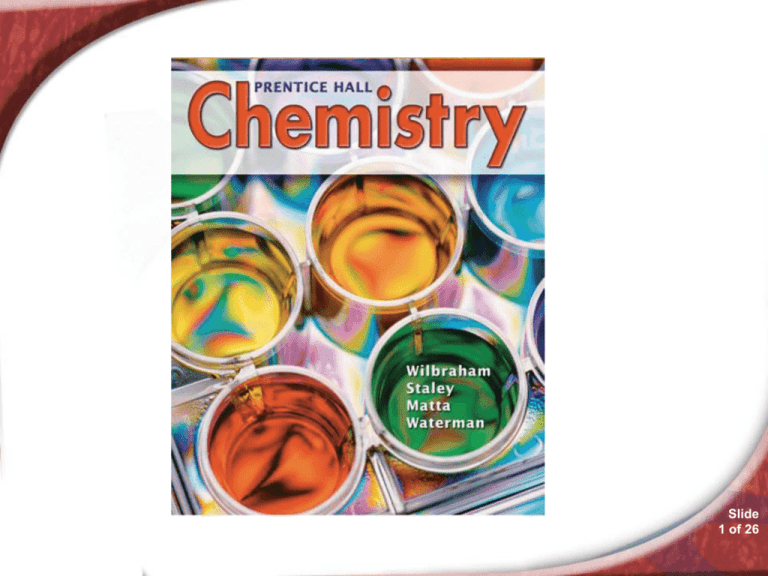
Chemistry
Slide
1 of 26
2.1
Properties of Matter
> Describing Matter
Properties can be classified as:
a. Physical: malleability, conductivity,
density, color, odor, volume, mass, etc…
b. Chemical: flammability, reactivity.
Slide
2 of 26
© Copyright Pearson Prentice Hall
Properties of Matter
> Describing Matter
Physical Properties can be classified
as:
a. Extensive: a property that depends
on the amount of matter in a sample
b. Intensive: a property that depends
on the type of matter in a sample.
Slide
3 of 26
© Copyright Pearson Prentice Hall
Properties of Matter
> Describing Matter
Properties
Physical
Intensive
Color,Odor,Density
Extensive
Chemical
Flammability & Reactivity
Mass,Volume,Length
© Copyright Pearson Prentice Hall
Slide
4 of 26
2.1
Properties of Matter
> Describing Matter
Extensive Properties Examples
•Mass
•Volume
•Weight
•Length
Slide
5 of 26
© Copyright Pearson Prentice Hall
2.1
Properties of Matter
> Describing Matter
Intensive Properties Examples
•Hardness
•Color
•Density
•Boiling/Melting Point
•Odor
Slide
6 of 26
© Copyright Pearson Prentice Hall
2.1
Properties of Matter
> Identifying Substances
Identifying Substances
Do all samples of a substance have
the same intensive properties?
Slide
7 of 26
© Copyright Pearson Prentice Hall
2.1
Properties of Matter
> Identifying Substances
Matter that has a uniform and definite
composition is called a substance.
Slide
8 of 26
© Copyright Pearson Prentice Hall
2.1
Properties of Matter
> Identifying Substances
This sculpture of a
falcon is made of gold.
Gold is an example of a
substance.
Slide
9 of 26
© Copyright Pearson Prentice Hall
2.1
Properties of Matter
> Identifying Substances
Every sample of a given substance has
identical intensive properties because
every sample has the same composition.
Examples: elements and compounds
Slide
10 of 26
© Copyright Pearson Prentice Hall
2.1
Properties of Matter
> Identifying Substances
A physical property is a quality or condition of a
substance that can be observed or measured
without changing the substance’s composition.
Hardness, color, conductivity, and malleability
are examples of physical properties.
Slide
11 of 26
© Copyright Pearson Prentice Hall
2.1
Properties of Matter
> States of Matter
Three commonly discussed states of
matter are solid, liquid, and gas.
(others: Plasma, Bose Einstein
Condensate)
Slide
12 of 26
© Copyright Pearson Prentice Hall
2.1
Properties of Matter
> States of Matter
Solids
A solid is a form of matter
that has a definite shape
and volume.
Slide
13 of 26
© Copyright Pearson Prentice Hall
2.1
Properties of Matter
> States of Matter
Liquid
A liquid is a form of matter
that has an indefinite
shape, flows, yet has a
fixed volume.
Slide
14 of 26
© Copyright Pearson Prentice Hall
2.1
Properties of Matter
> States of Matter
Gases
A gas is a form of matter that
takes both the shape and
volume of its container.
(indefinite shape and
volume)
Slide
15 of 26
© Copyright Pearson Prentice Hall
2.1
Properties of Matter
> States of Matter
Vapor describes the gaseous state of a
substance that is generally a liquid or
solid at room temperature, as in water
vapor.
Slide
16 of 26
© Copyright Pearson Prentice Hall
2.1
Properties of Matter
> Physical Changes
Physical Changes
How can physical changes be
classified?
Slide
17 of 26
© Copyright Pearson Prentice Hall
2.1
Properties of Matter
> Physical Changes
During a physical
change, some properties
of a material change, but
the composition of the
material does not change.
As gallium melts in a
person’s hand, the shape
of the sample changes, but
the composition of the
material does not change.
Slide
18 of 26
© Copyright Pearson Prentice Hall
2.1
Properties of Matter
> Physical Changes
Physical changes can be classified as
reversible or irreversible.
• All physical changes that involve a
change from one state to another are
reversible (evaporation, condensation,
etc...)
• Cutting hair, filing nails, and cracking an
egg are examples of irreversible physical
changes.
Slide
19 of 26
© Copyright Pearson Prentice Hall
2.1 Section Quiz.
Assess students’ understanding
of the concepts in Section 2.1.
Continue to:
-or-
Launch:
Section Quiz
Slide
20 of 26
© Copyright Pearson Prentice Hall
2.1 Section Quiz.
1. Which of the following would be described as
an extensive property of matter?
a. temperature
b. color
c. mass
d. hardness
Slide
21 of 26
© Copyright Pearson Prentice Hall
2.1 Section Quiz.
2. Which properties can be observed without
changing the composition of a substance?
a. all properties of a substance
b. intensive properties
c. chemical properties
d. physical properties
Slide
22 of 26
© Copyright Pearson Prentice Hall
2.1 Section Quiz.
3. Match the states of matter with the following
descriptions:
(1) takes the volume and shape of its container
(2) has a definite shape and volume
(3) has a definite volume but an indefinite shape
a. (1) liquid, (2) solid and (3) gas
b. (1) gas, (2) solid, and (3) liquid
c. (1) gas, (2) liquid, and (3) solid
Slide
23 of 26
© Copyright Pearson Prentice Hall
END OF SHOW








